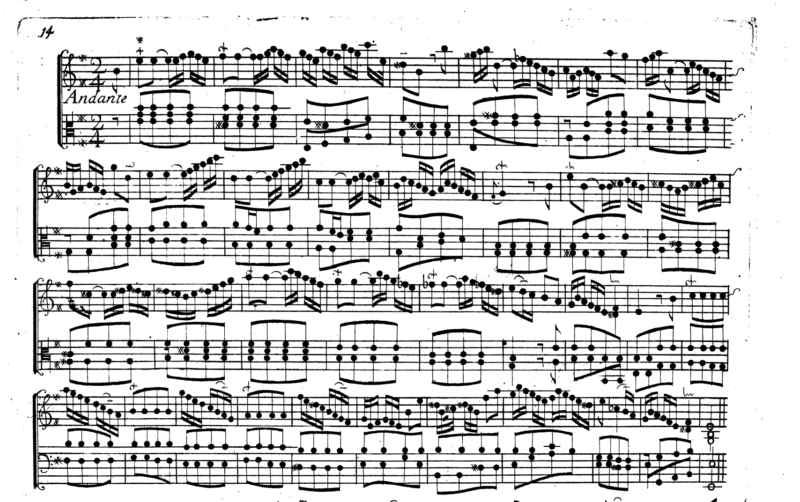Moderate
A list

Cimarosa ~ Allegro (A1). Too slow a tempo here could cause the piece to feel musically rather dull. Aim to avoid any hint of regular onbeat accentuation. It should have a 6/8 sense of character so if it becomes too quick, with a more one-in-a-bar feel such as here, then opportunities for more shaped and poised phrasing are lost:
Played on a period instrument, the tempo and feel would likely have been very different, but on the piano of today there is plenty that can be done to add more variety to the playing, as proposed by the many suggestions for dynamic changes (probably editorial).
Haydn ~ Minuet and Trio (A2). Where and how do you start teaching a particular piece? If we always begin the learning journey at the piano, via the dots on the page, then it could be some time before we ever get to the point where playing and enjoying the sound of what we are doing becomes real. There are advantages to listening and watching top performers having fun through the music they are making. Here is an example of what feels like chamber music at its best. Whilst it's a quicker three-time than this minuet and trio, you can glean a great deal about the phrasing, the forte/piano changes, the buoyancy of mood, and the lyricism which will, hopefully, become an intrinsic part of a really good performance of Minuet and Trio.
J.S.Bach ~ Invention No. 8 in F (A4) is a great piece to work at true independence of hands. The key to achieving this lies in the ability to phrase both hands with the same motivic articulation, even though the left hand plays its musical material a bar later.
Beethoven ~ Bagatelle in G minor, Op 119 no. 1 (A5) makes a renewed appearance. It is a lyrical minor key bagatelle, not particularly brisk or energetic. Notice the quite tentative, questioning manner of the opening phrases in Yulia Chaplina's performance (ABRSM Grade 5 recordings).
If the playing has a musical narrative, then the performance is likely to have a satisfying structure to it. Note how the carefully chosen initial tempo allows the performer sufficient time and space to phrase the imitative effects at the end without feeling rushed.
Fiocco ~ Andante (A6). Isn't this an easy piece? On the surface of it, yes! The notes are not difficult and the constant left hand quaver flow makes for uncomplicated coordination between the hands. The expressive possibilities of the harpsichord, on which it was undoubtedly played originally, are not comparable to the piano and that would account for the preponderance of ornamentation in the score - as you can see from this 1730s edition.

Expressive lyrical playing will always be a winner when it comes to performing this piece. It helps to include some ornamentation (played on, not before the beat), but this can be minimal.
Hummel ~Allegro in C (A8) is a delightful piece. The theme itself may sound deceptively easy. Whilst a quicker musical momentum develops, the piece is a really good choice through which to explore Classical poise in playing, with some nimble finger work too.
Mozart ~ Theme, Var. 1 and Var. 5 (A10) - a cheeky and charming taster from Mozart's complete set of 12 Variations, based on the popular French children's song. The tempo should not be quick. It is better that the semiquaver embellishments are poised and well-phrased and not scrambled in variation 1. Therefore the theme requires a well-judged tempo and an eloquent sense of phrasing.
Heller ~ Study in E minor No. 7 (A12) is a lively gigue-like piece although does not need to be taken very fast to be effective. Importantly, the even flow of rhythmically articulated right hand quavers is a key to success here.
Leo ~ Toccata No 3 (A13) is not a fast toccata, but a more poised three-in-a-bar affair with the allocation of semiquaver patterns to the right hand, whilst the left hand supports the flow with a stylish detached left hand quaver bass line.
_____________________________
B list

Hofmann ~ Minnelied (A1) is, as the title suggests, a song. In this case, it is more like a duet between the soprano and tenor voices. Together, the right and left hand quaver parts contain the harmonic flow. The middle semiquaver part is the engine that keeps the tempo running, an engine that should purr away quietly in the background and, like a powerful car, be responsive to slight changes in the musical terrain as it glides over the phrases with its supple rubato.
Dorothy Pilling ~ Philomela (B3) is a heartfelt, poignant lament. There is much sudden swelling of strong emotion before quickly once again dissipating back to her inner soul. Philomela, as the Greek mythology suggests, was raped and left mutilated by her sister's husband. Her transformation into a nightingale allows her to express her sadness and reveal her innermost tenderness with newfound freedom.
Very much in the mould of Philomela, R.R.Bennett ~ Little Elegy (B4) describes a poignant reflection on a loved one's passing. The character is mournful, the sense of inner pain expressed through its wandering chromaticism, yet tinged with tender moments of reminiscence and reminders of a tender soul held in memory.
A different kind of inner strife comes in Granados La huérfana (B5). There is a simple beauty in the way Alicia de Larrocha expresses the deep sense of hurt that the orphan feels as she wanders constantly in search of her past. Listen to how the playing is poignant but not sentimental, the colours of grief drawn out as much through her attention to textural detail as it is to any outward over-indulgence in rubato.
Pachulski ~ Prelude in C minor (B9) is a poetic piece, again somewhat introspective in mood. It relies on a well-projected right hand cantabile line with a supple and subtle chugging accompaniment in the left hand and careful use of pedal.
Gliere ~ Evening (B11) makes a welcome return to the syllabus. The outer sections are understated yet gently expressive, whilst the middle section has brighter moments with glimpses of major key tonalities. It could sound rather ordinary, should the syncopated accompanimental flow of notes be too loud or have too much accentuation, so a key factor to musical success here is to ensure a really good, and consistent balance between the hands.
Philip Lane ~ A Walk in the Park (B12) is a pleasantly meandering stroll through some entrancing harmonies, often tinged with hints of jazz-influenced colours.
Trad. Korean ~ Arranged Bullard (B13) is a gently expressive, appealing piece with some surprising and lovely harmonic changes. Melodic lines appear at different times in either hand, and there is a suppleness to the phrasing which helps to foster a mood of enchantment.
_____________________________
C list

Playing jazz in a band is so much easier than going it alone. Mike Cornick ~ In the Groove (C1) is a fun piece to play, although you have the task of creating and maintaining the groove. That said, there is so much that can be done together in the lesson to promote a good grasp of that swing feel. Classical players have an inappropriate tendency, in jazz, to phrase things away from the beat and to 'place' beats, rather than phrasing within the groove and letting the groove be the muscle that gives impetus to the playing.
Practise the left hand sustained chords as if these are the muted tones of the horn section. Noting the difference between a slur ending without any accent and staccato chords with an accent will help to get into the mood and create a performance that really swings.
Kabalevsky ~ Scherzo (C2) To achieve the scherzando aspect of this piece, the rise and fall of the indicated dynamics should be followed. There is also room for a little rubato to add cheekiness to the playing. There is a scampering leggierissimo quality to the mood which, from a technical standpoint, requires crispness and clarity throughout its chord articulation.
Bartok ~ Winter Solstice Song (C6) creates a throbbing celebration from this darkest time of year. The piece is brimming with festive energy, communicated in the form of a perpetual, solid heartbeat running unwaveringly throughout the piece. This is the technical challenge - to keep those left hand fingers absolutely solid and evenly controlled. Throughout the long poco a poco crescendo and diminuendo, the pulse must remain constant. It might be exciting, but it's pagan!
Pinto ~ March, Little Soldier! (C9) is a quirky piece. Pinto's sense of humour is very apparent. Having stood all the soldiers in a row, the imagination of the child has assumed that they will march of their own accord and, when they don't, there's a tantrum or two before realisation comes to the rescue!
Arlen ~ Stormy Weather arr. Iles (C11). Another great arrangement from jazz pianist Nikki Iles. To get the loose feel so typical here, listen to her own performance on the ABRSM Grade 5 recording. Better still, listen to Ella Fitzgerald's 1961 recording. It's a masterclass in how to phrase a line with such easy cool and make something so expressive out of what might have been bad news!
Creating that lazy swing feel is also an important feature in Martha Mier ~ Tuxezo Jass (C12). It's easy for the groove to become more dotted, busy, and less truly laid back, so strive for that effect by listening to other swing repertoire and remember that there's no harm in recording yourself to hear what you are actually doing.
_____________________________
Other content in “Grade 5”
-
Current: Moderate
